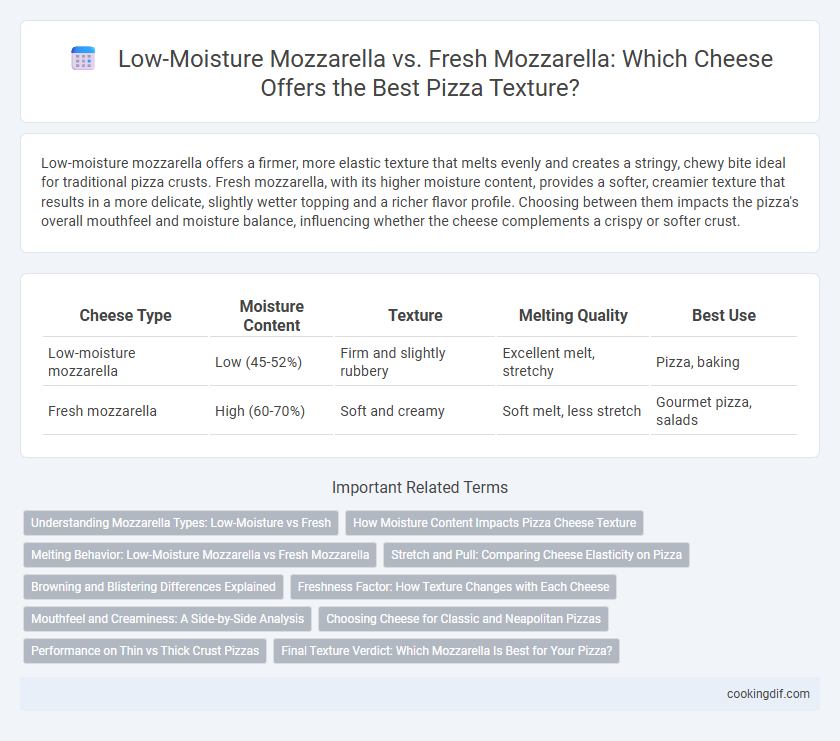Low-moisture mozzarella offers a firmer, more elastic texture that melts evenly and creates a stringy, chewy bite ideal for traditional pizza crusts. Fresh mozzarella, with its higher moisture content, provides a softer, creamier texture that results in a more delicate, slightly wetter topping and a richer flavor profile. Choosing between them impacts the pizza's overall mouthfeel and moisture balance, influencing whether the cheese complements a crispy or softer crust.
Table of Comparison
| Cheese Type | Moisture Content | Texture | Melting Quality | Best Use |
|---|---|---|---|---|
| Low-moisture mozzarella | Low (45-52%) | Firm and slightly rubbery | Excellent melt, stretchy | Pizza, baking |
| Fresh mozzarella | High (60-70%) | Soft and creamy | Soft melt, less stretch | Gourmet pizza, salads |
Understanding Mozzarella Types: Low-Moisture vs Fresh
Low-moisture mozzarella, with its denser texture and reduced water content, offers a firmer, meltier consistency ideal for traditional pizza baking and achieving a golden, bubbly crust. Fresh mozzarella contains higher moisture levels, resulting in a creamier, softer texture that creates a delicate melt but can sometimes release excess water, affecting the pizza's crispiness. Choosing between low-moisture and fresh mozzarella directly influences the pizza's texture, melt quality, and overall flavor balance, making it essential to consider the specific pizza style and baking method.
How Moisture Content Impacts Pizza Cheese Texture
Low-moisture mozzarella contains about 45-52% moisture, resulting in a firmer, stretchier texture and better meltability ideal for pizza. Fresh mozzarella has a high moisture content around 60-70%, producing a creamier, softer texture but can release excess water, affecting pizza crust crispiness. The moisture content directly impacts cheese melt behavior, stretch, and overall pizza texture, with low-moisture mozzarella preferred for a controlled melt and fresh mozzarella for a richer, creamier bite.
Melting Behavior: Low-Moisture Mozzarella vs Fresh Mozzarella
Low-moisture mozzarella offers a firmer texture and superior stretchability due to its reduced water content, making it ideal for consistent, even melting on pizzas. Fresh mozzarella contains higher moisture, resulting in a creamier texture but often releases excess liquid during baking, which can affect the crust's crispiness. The melting behavior of low-moisture mozzarella ensures a stable, golden-brown finish, while fresh mozzarella contributes a softer, more delicate melt that enhances flavor but may require careful moisture management.
Stretch and Pull: Comparing Cheese Elasticity on Pizza
Low-moisture mozzarella offers superior stretch and pull due to its lower moisture content and higher fat, creating a chewy, elastic texture ideal for classic New York-style pizza. Fresh mozzarella, with higher moisture, produces a creamier, softer melt but less elasticity and stretch, resulting in a delicate, tender bite. Pizza makers often choose low-moisture mozzarella for its consistent pull and meltability, enhancing the visual and textural appeal of stretched cheese slices.
Browning and Blistering Differences Explained
Low-moisture mozzarella offers superior browning and blistering due to its lower water content, which allows it to caramelize and develop a golden, crispy texture on pizza. Fresh mozzarella has higher moisture, resulting in a creamier consistency but less browning and fewer blistered spots when baked. Pizza chefs often choose low-moisture mozzarella for a traditional browned crust, while fresh mozzarella is favored for a soft, milky melt.
Freshness Factor: How Texture Changes with Each Cheese
Fresh mozzarella offers a soft, creamy texture that melts smoothly, creating a fresh and moist mouthfeel ideal for Neapolitan-style pizzas. Low-moisture mozzarella has a denser, firmer texture that provides excellent stretchiness and a more pronounced chew, which enhances the overall bite and structure in New York-style pizzas. The freshness factor directly influences moisture content, with fresh mozzarella delivering a juicier, tender melt, while low-moisture mozzarella results in a more controlled, consistent texture during baking.
Mouthfeel and Creaminess: A Side-by-Side Analysis
Low-moisture mozzarella delivers a firmer texture with a slightly elastic bite, offering a consistent melt ideal for pizza crusts, while fresh mozzarella provides a soft, creamy mouthfeel that melts into a luscious, smooth layer. The lower water content in low-moisture mozzarella contributes to its stretchiness and moderate creaminess, whereas fresh mozzarella's higher moisture content creates a delicate, moist creaminess that enhances richness but can result in a softer, less structured cheese layer. Texture-wise, low-moisture mozzarella emphasizes chewiness and controlled melt, whereas fresh mozzarella focuses on a velvety, tender bite that appeals to those seeking creaminess over firmness.
Choosing Cheese for Classic and Neapolitan Pizzas
Low-moisture mozzarella offers a firmer texture and browns evenly, making it ideal for classic American-style pizzas where a consistent melt and stretch are desired. Fresh mozzarella provides a softer, creamier texture with higher moisture content, perfect for Neapolitan pizzas that benefit from its delicate melt and fresh flavor. Selecting between low-moisture and fresh mozzarella depends on the desired crust moisture balance and overall cheese melt characteristics essential for replicating authentic pizza styles.
Performance on Thin vs Thick Crust Pizzas
Low-moisture mozzarella offers a firmer texture and superior melt consistency ideal for thin crust pizzas, providing a crisp balance without excess moisture that can sog the base. Fresh mozzarella, with its higher moisture content and creamy texture, excels on thick crust pizzas by adding a rich, gooey layer that enhances softness and chewiness. Thin crust pizzas benefit from the low-moisture variety's ability to brown evenly and maintain structural integrity, while thick crust pizzas capitalize on fresh mozzarella's elasticity and moisture to complement the dough's density.
Final Texture Verdict: Which Mozzarella Is Best for Your Pizza?
Low-moisture mozzarella offers a firmer texture and better melting qualities, creating a classic stretchy and golden-brown cheese topping ideal for traditional pizzas. Fresh mozzarella provides a creamier, softer texture with a higher moisture content, resulting in a delicate, slightly bubbly finish that complements artisanal or Neapolitan-style pizzas. For a balanced texture that achieves both meltability and moisture, low-moisture mozzarella is best suited for most pizza styles seeking a reliable, consistent cheese crust.
Low-moisture mozzarella vs Fresh mozzarella for cheese texture Infographic

 cookingdif.com
cookingdif.com